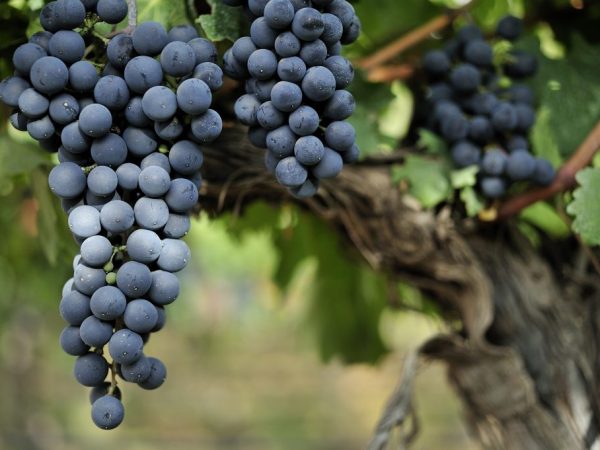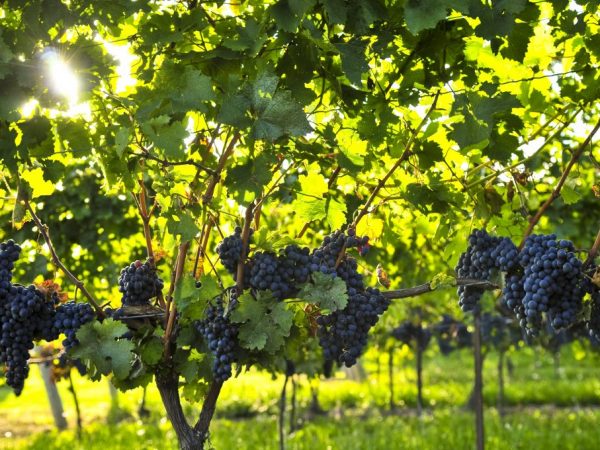Description of the grape variety Livadia black
Among connoisseurs of quality wine, the black Livadia grape is especially recognized. It combines excellent aroma, large amount of juice and a high level of sugar content. All together, it makes it possible to produce amazingly tasty dessert wines from the fruits of this variety.

Description of the grape variety Livadia black
general characteristics
Livadia black grape is a hybrid created by the Maragach Institute.
Description of the variety:
- medium early (ripens about 140 days from the moment the buds open);
- has high yield rates and excellent taste;
- resistant to disease and insect attack.
Bush characteristic
The plant reaches its maximum possible size only after reaching the age of 3-4 years. The number of shoots capable of bearing fruit by this time is 75-80%. They can withstand a load of 50 kg. One shoot accounts for 1.3-1.4 kg of berries, so the bush belongs to the category of having an average vigor. The flowers are bisexual.
Bunches are small, medium density and cylindrical in shape. The weight of one is about 200-250 g.
Description of fruits
Description of berries of the Livadiysky black variety:
- the shape of the fruit is round or slightly elongated;
- Grapes of a deep blue, almost black hue with a pronounced purine dusting;
- the size of the berries is small, the weight of each is up to 2 g.
The juice content in fruits is high, 80-90%. They have a pleasant sweetish taste, sugar index - 25-26%, acidity - 6-10 g / l. The berries have a thin but firm skin with a slight nutmeg scent. Yield indicators - 130-150 c / ha.
The acidity and sugar content may decrease if the fruits are overexposed on the vine.
In the period of maturity, the fastening of the fruit loses its strength, so the grapes begin to crumble. It is important to harvest the harvest at the right time, otherwise the grapes will lose their profitable appearance, and the berries will lose their taste.
Growing grapes
Previously, the grape variety Livadia black was grown only on the territory of Crimea. Over time, it was possible to change the indicators of frost resistance of the variety, which made it possible to increase the geography of cultivation.
Landing in the soil
Grapes are picky about the soil, as well as the content of salts and minerals in it, therefore, when planting, you should carefully consider the choice: place, seedling and breeding method:
- the landing site should be well lit;
- the variety is sensitive to soil, so it is better if it is black soil;
- it is imperative that the bush has a support.
Plant care

Taking care of the plant is not difficult
Vine care involves regular feeding and preparation of the bush for the winter period. As soon as the bunches ripen on the vine, the bad ones are immediately removed so that they do not take away strength. The number of clusters is commensurate with the age of the bush. Dried leaves are also cut off: they prevent the berries from receiving the right amount of light.
Fertilizer
The first time fertilizer is applied during planting.This is done so that the plant can quickly acclimatize and take root in the soil. Further, they establish regular feeding for the normal growth and development of vines and fruits.
Watering
Livadia black grape variety does not need additional watering. A dry, sunny climate suits it. The plant has enough moisture that it receives naturally.
Diseases and pests
Livadia black grapes have high rates of resistance to many diseases and pests.
Fight disease
According to the description, the black Livadia variety has a predisposition to bacterial diseases. The most common:
- Powdery mildew. The bacteria are spread through water. The main feature of the disease is that spores can overwinter on leaves or in the soil. To prevent the spread of powdery mildew, all waste is removed around the plant, fungicidal spraying of the soil is performed.
- Apoplexy. It is an incurable disease. The affected bush withers quickly. The only protective measure is proper plant care, timely fertilization.
- Cancer. Pathogens live in all types of soil. The disease is not treatable. After determining the lesion, the plant is burned. For 2-3 years, new bushes cannot be planted at the site of the development of the disease.
- White rot. It strikes the fruit first. After that, it moves to the shoots, which gradually dry out. Methods of dealing with white rot are simple: infected brushes are completely removed from the vine, the bush is treated with Fundozol or Kolfugo Super.
Another plant affects rubella, anthracnose, oidium.
Pest control
Dangerous harmful insects include:
- mite;
- grape flea and mosquito;
- wasps and aphids;
- cicadas and woodworms;
- weevils and worms.
They feed on leaves and young shoots. The development of insects occurs with the laying of eggs on the leaves, therefore, contact insecticides should be treated. To combat woodworm, the damaged shoots are first removed, then spraying is carried out.
Prophylaxis
The Livadia black variety is unpretentious, therefore, prevention is minimal. Weeding the bushes is carried out, the fruits are examined for the appearance of pests or the development of the disease. If there are any, the affected leaves or fruits are removed immediately.
Conclusion
Black variety Livadiyskiy - decoration of the site and table.


